air condition DACIA LODGY 2012 1.G Owners Manual
[x] Cancel search | Manufacturer: DACIA, Model Year: 2012, Model line: LODGY, Model: DACIA LODGY 2012 1.GPages: 196, PDF Size: 5.73 MB
Page 70 of 196
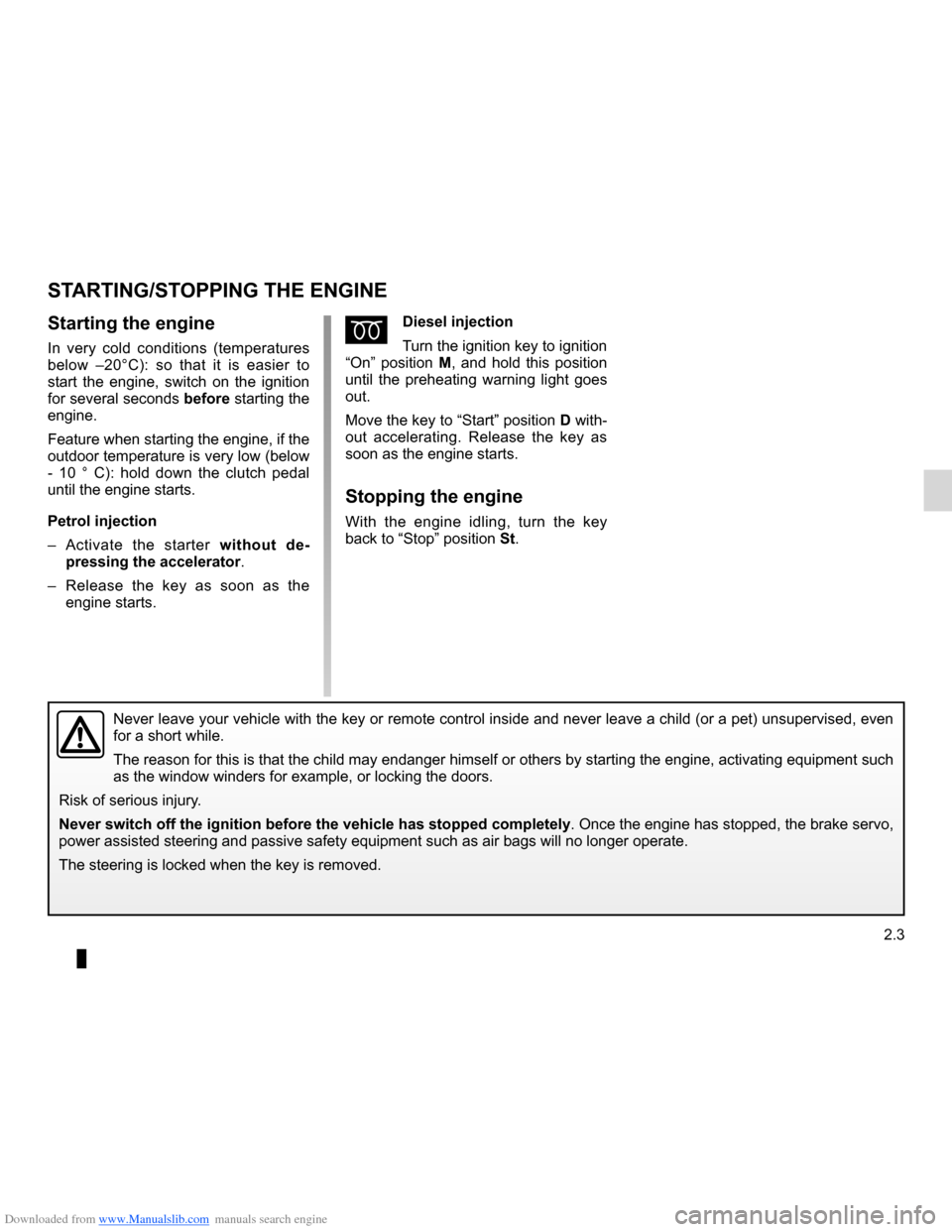
Downloaded from www.Manualslib.com manuals search engine driving ................................................... (up to the end of the DU)
starting .................................................. (up to the end of the DU)
starting the engine ................................ (up to the end of the DU)
2.3
ENG_UD28712_3
Démarrage, Arrêt du moteur (X92 - Renault)
ENG_NU_975-3_X92_Dacia_2
ÉDiesel injection
Turn the ignition key to ignition
“On” position M, and hold this position
until the preheating warning light goes
out.
Move the key to “Start” position D with-
out accelerating. Release the key as
soon as the engine starts.
Stopping the engine
With the engine idling, turn the key
back to “Stop” position St.
Starting the engine
In very cold conditions (temperatures
below –20°C): so that it is easier to
start the engine, switch on the ignition
for several seconds before starting the
engine.
Feature when starting the engine, if the
outdoor temperature is very low (below
- 10 ° C): hold down the clutch pedal
until the engine starts.
Petrol injection
– Activate the starter without de-
pressing the accelerator.
– Release the key as soon as the
engine starts.
Starting, Stopping the engine
STARTING/STOPPING THE ENGINE
Never leave your vehicle with the key or remote control inside and never leave a child (or a pet) unsupervised, even
for a short while.
The reason for this is that the child may endanger himself or others by starting the engine, activating equipment such
as the window winders for example, or locking the doors.
Risk of serious injury.
Never switch off the ignition before the vehicle has stopped completely. Once the engine has stopped, the brake servo,
power assisted steering and passive safety equipment such as air bags wi\
ll no longer operate.
The steering is locked when the key is removed.
Page 71 of 196
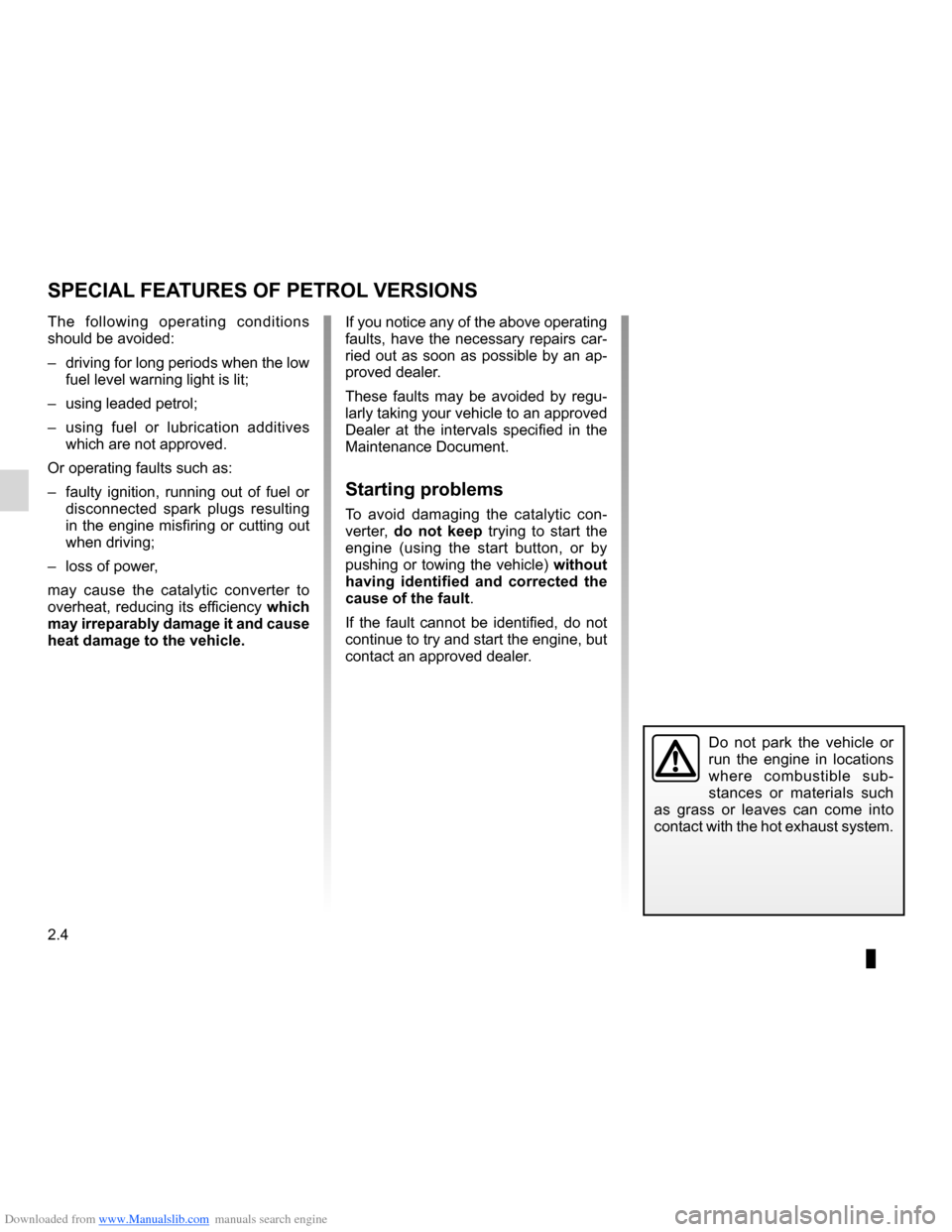
Downloaded from www.Manualslib.com manuals search engine special features of petrol vehicles ........ (up to the end of the DU)
driving ................................................... (up to the end of the DU)
catalytic converter ................................. (up to the end of the DU)
2.4
ENG_UD10826_1
Particularités des versions essence (X95 - J95 - R95 - Renault)
ENG_NU_975-3_X92_Dacia_2
Special features of petrol versions
SPECIAl fEATURES Of PETROl vERSIONS
Do not park the vehicle or
run the engine in locations
where combustible sub -
stances or materials such
as grass or leaves can come into
contact with the hot exhaust system.
The following operating conditions
should be avoided:
– driving for long periods when the low
fuel level warning light is lit;
– using leaded petrol;
– using fuel or lubrication additives
which are not approved.
Or operating faults such as:
– faulty ignition, running out of fuel or
disconnected spark plugs resulting
in the engine misfiring or cutting out
when driving;
– loss of power,
may cause the catalytic converter to
overheat, reducing its efficiency which
may irreparably damage it and cause
heat damage to the vehicle. If you notice any of the above operating
faults, have the necessary repairs car-
ried out as soon as possible by an ap-
proved dealer.
These faults may be avoided by regu
-
larly taking your vehicle to an approved
Dealer at the intervals specified in the
Maintenance Document.
Starting problems
To avoid damaging the catalytic con -
verter, do not keep trying to start the
engine (using the start button, or by
pushing or towing the vehicle) without
having identified and corrected the
cause of the fault.
If the fault cannot be identified, do not
continue to try and start the engine, but
contact an approved dealer.
Page 75 of 196

Downloaded from www.Manualslib.com manuals search engine 2.8
ENG_UD19988_2
Conseils antipollution, économies de carburant, conduite (X65 - X65 \
PH5 - Renault)
ENG_NU_975-3_X92_Dacia_2
ADvICE: antipollution, fuel economy and driving (3/3)
Advice on use
– Electricity is fuel; switch off all the
electrical components which are
not really needed. However (safety
first), keep your lights on when the
visibility is bad (“see and be seen”).
– Use the air vents. Driving with the
windows open at 60 mph (100 km/h)
will increase fuel consumption by
4%.
– Avoid using the car for door-to-door
calls (short journeys with long waits
in between) because the engine
never reaches its normal operating
temperature.
Tyres
– An underinflated tyre increases fuel
consumption.
– The use of non-recommended tyres
can increase fuel consumption.
–
In vehicles fitted with air condi -
tioning, it is normal to observe an
increase in fuel consumption (es -
pecially in urban conditions) when
it is used. For vehicles fitted with
manual air conditioning, switch off
the system when it is not required.
Advice for reducing consumption
and therefore helping to preserve
the environment:
If the vehicle has been parked in the
sun, open the doors for a few mo -
ments to let the hot air escape before
starting the engine.
– Never fill the fuel tank right to the
brim to avoid overflow.
– Do not leave an empty roof rack
fitted to the vehicle.
– It is better to fit a trailer for bulky ob-
jects.
– When towing a caravan, fit a wind
deflector and adjust it carefully.
Page 86 of 196

Downloaded from www.Manualslib.com manuals search engine 3.1
ENG_UD28065_3
Sommaire 3 (X92 - Renault)
ENG_NU_975-3_X92_Dacia_3
Section 3: Your comfort
Air vents, air outlets . . . . . . . . . . . . . . . . . . . . . . . . . . . . . . . . . . . . . . . . . . . . . . . . . . . . . . . . . . . . . . 3.2
Heating, Ventilation, Air conditioning . . . . . . . . . . . . . . . . . . . . . . . . . . . . . . . . . . . . . . . . . . . . . . . . . 3.4
Air conditioning: information and advice on use . . . . . . . . . . . . . . . . . . . . . . . . . . . . . . . . . . . . . . . . 3.7
Electric windows . . . . . . . . . . . . . . . . . . . . . . . . . . . . . . . . . . . . . . . . . . . . . . . . . . . . . . . . . . . . . . . . 3.8
Interior lighting . . . . . . . . . . . . . . . . . . . . . . . . . . . . . . . . . . . . . . . . . . . . . . . . . . . . . . . . . . . . . . . . . . 3.10
Sun visor, Grab handle . . . . . . . . . . . . . . . . . . . . . . . . . . . . . . . . . . . . . . . . . . . . . . . . . . . . . . . . . . . 3.11
Passenger compartment storage space and fittings . . . . . . . . . . . . . . . . . . . . . . . . . . . . . . . . . . . . . 3.12
Ashtrays, Cigarette lighter, Accessories socket . . . . . . . . . . . . . . . . . . . . . . . . . . . . . . . . . . . . . . . . . 3.16
Rear headrests . . . . . . . . . . . . . . . . . . . . . . . . . . . . . . . . . . . . . . . . . . . . . . . . . . . . . . . . . . . . . . . . . 3.17
Rear seats: . . . . . . . . . . . . . . . . . . . . . . . . . . . . . . . . . . . . . . . . . . . . . . . . . . . . . . . . . . . . . . . . . . . . 3.19
second row . . . . . . . . . . . . . . . . . . . . . . . . . . . . . . . . . . . . . . . . . . . . . . . . . . . . . . . . . . . . . . . 3.19
third row . . . . . . . . . . . . . . . . . . . . . . . . . . . . . . . . . . . . . . . . . . . . . . . . . . . . . . . . . . . . . . . . . 3.22
grouping of seats . . . . . . . . . . . . . . . . . . . . . . . . . . . . . . . . . . . . . . . . . . . . . . . . . . . . . . . . . . 3.25
Luggage compartment . . . . . . . . . . . . . . . . . . . . . . . . . . . . . . . . . . . . \
. . . . . . . . . . . . . . . . . . . . . . . . 3.28
Luggage compartment storage space and fittings . . . . . . . . . . . . . . . . . . . . . . . . . . . . . . . . . . . . . . 3.29
Transporting objects in the boot . . . . . . . . . . . . . . . . . . . . . . . . . . . . . . . . . . . . . . . . . . . . . . . . . . . . 3.30
Transporting objects: towing, attachments . . . . . . . . . . . . . . . . . . . . . . . . . . . . . . . . . . . . . . . . . . . . 3.31
Luggage net . . . . . . . . . . . . . . . . . . . . . . . . . . . . . . . . . . . . \
. . . . . . . . . . . . . . . . . . . . . . . . . . . . . . . . 3.32
Luggage cover . . . . . . . . . . . . . . . . . . . . . . . . . . . . . . . . . . . . . . . . . . . . . . . . . . . . . . . . . . . . . . . . . . 3.33
Multimedia equipment . . . . . . . . . . . . . . . . . . . . . . . . . . . . . . . . . . . . . . . . . . . . . . . . . . . . . . . . . . . . 3.34
Page 87 of 196
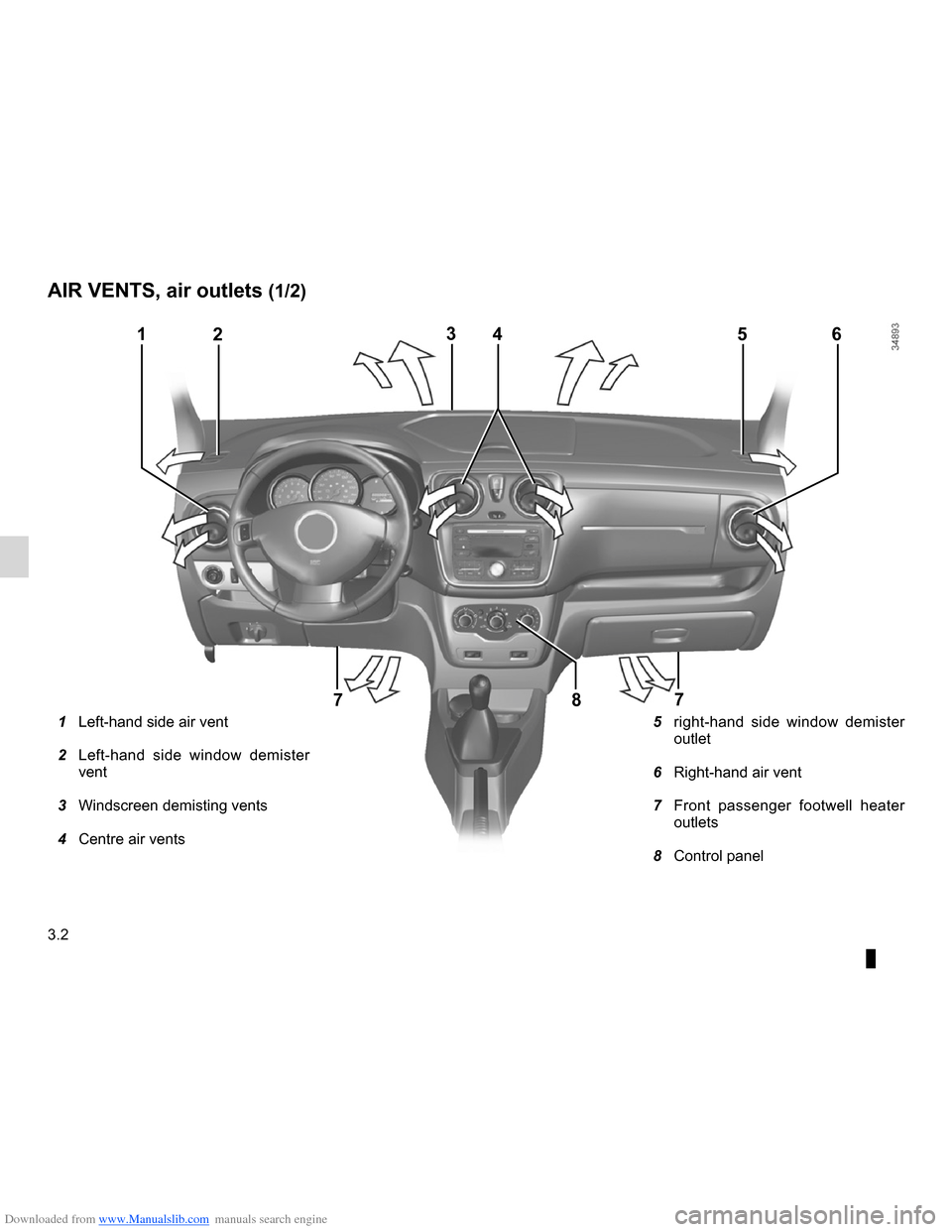
Downloaded from www.Manualslib.com manuals search engine air vents ................................................ (up to the end of the DU)
heating system ..................................... (up to the end of the DU)
heating and air conditioning system ..... (up to the end of the DU)
3.2
ENG_UD24439_1
Aérateurs, sorties air (X92 - Renault)
ENG_NU_975-3_X92_Dacia_3
Jaune NoirNoir texte
Air vents, air outlets
AIR VENTS, air outlets (1/2)
5 right-hand side window demister
outlet
6 Right-hand air vent
7 Front passenger footwell heater
outlets
8 Control panel
1 Left-hand side air vent
2 Left-hand side window demister
vent
3 Windscreen demisting vents
4 Centre air vents
12365
77
4
8
Page 89 of 196
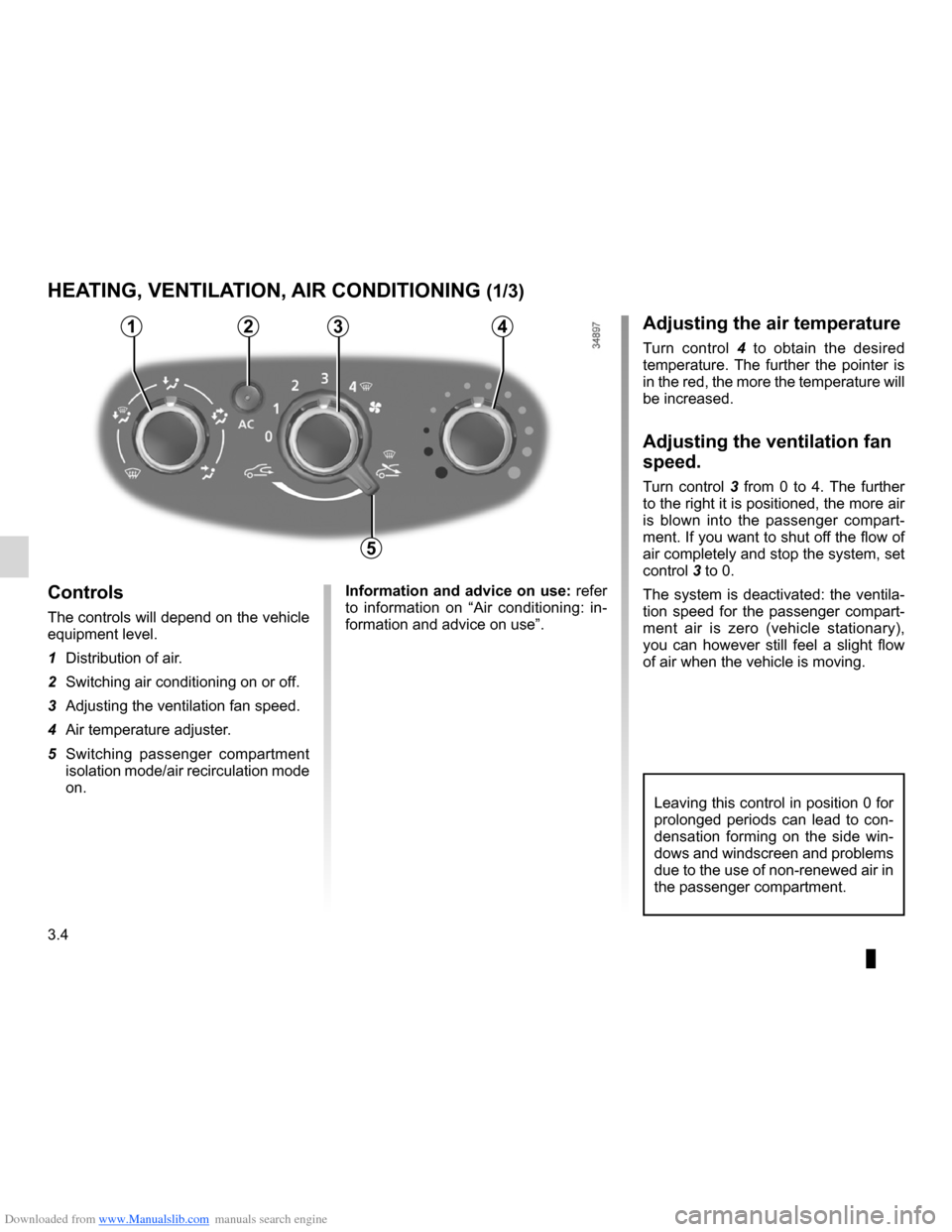
Downloaded from www.Manualslib.com manuals search engine air conditioning ..................................... (up to the end of the DU)
heating and air conditioning system ..... (up to the end of the DU)
heating system ..................................... (up to the end of the DU)
ventilation heating and air conditioning system (up to the end of the DU)
air conditioning ..................................... (up to the end of the DU)
3.4
ENG_UD28036_3
Chauffage - Ventilation - Air conditionné (X92 - Renault)
ENG_NU_975-3_X92_Dacia_3
Jaune NoirNoir texte
Heating, Ventilation, Air conditioning
HEATING, VENTILATION, AIR CONDITIONING (1/3)
Controls
The controls will depend on the vehicle
equipment level.
1 Distribution of air.
2 Switching air conditioning on or off.
3 Adjusting the ventilation fan speed.
4 Air temperature adjuster.
5 Switching passenger compartment
isolation mode/air recirculation mode
on.
Leaving this control in position 0 for
prolonged periods can lead to con-
densation forming on the side win -
dows and windscreen and problems
due to the use of non-renewed air in
the passenger compartment.
Adjusting the air temperature
Turn control 4 to obtain the desired
temperature. The further the pointer is
in the red, the more the temperature will
be increased.
Adjusting the ventilation fan
speed.
Turn control 3 from 0 to 4. The further
to the right it is positioned, the more air
is blown into the passenger compart -
ment. If you want to shut off the flow of
air completely and stop the system, set
control 3 to 0.
The system is deactivated: the ventila -
tion speed for the passenger compart-
ment air is zero (vehicle stationary),
you can however still feel a slight flow
of air when the vehicle is moving.
Information and advice on use: refer
to information on “Air conditioning: in -
formation and advice on use”.
4321
5
Page 90 of 196
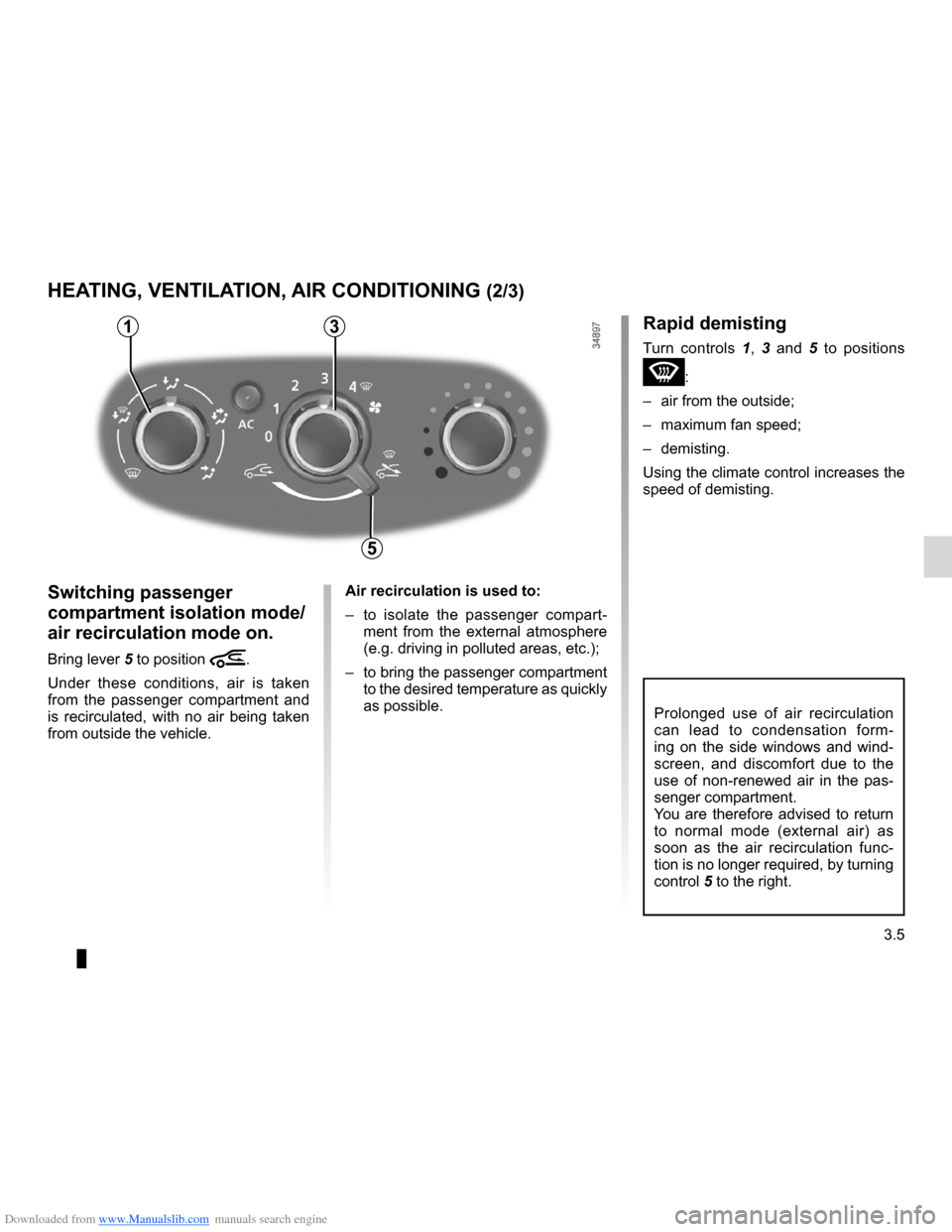
Downloaded from www.Manualslib.com manuals search engine JauneNoirNoir texte
3.5
ENG_UD28036_3
Chauffage - Ventilation - Air conditionné (X92 - Renault)
ENG_NU_975-3_X92_Dacia_3
HEATING, VENTILATION, AIR CONDITIONING (2/3)
Switching passenger
compartment isolation mode/
air recirculation mode on.
Bring lever 5 to position â.
Under these conditions, air is taken
from the passenger compartment and
is recirculated, with no air being taken
from outside the vehicle. Air recirculation is used to:
–
to isolate the passenger compart -
ment from the external atmosphere
(e.g. driving in polluted areas, etc.);
– to bring the passenger compartment
to the desired temperature as quickly
as possible.
Prolonged use of air recirculation
can lead to condensation form -
ing on the side windows and wind -
screen, and discomfort due to the
use of non-renewed air in the pas -
senger compartment.
You are therefore advised to return
to normal mode (external air) as
soon as the air recirculation func -
tion is no longer required, by turning
control 5 to the right.
31
5
Rapid demisting
Turn controls 1 , 3 and 5 to positions
W:
– air from the outside;
– maximum fan speed;
– demisting.
Using the climate control increases the
speed of demisting.
Page 91 of 196
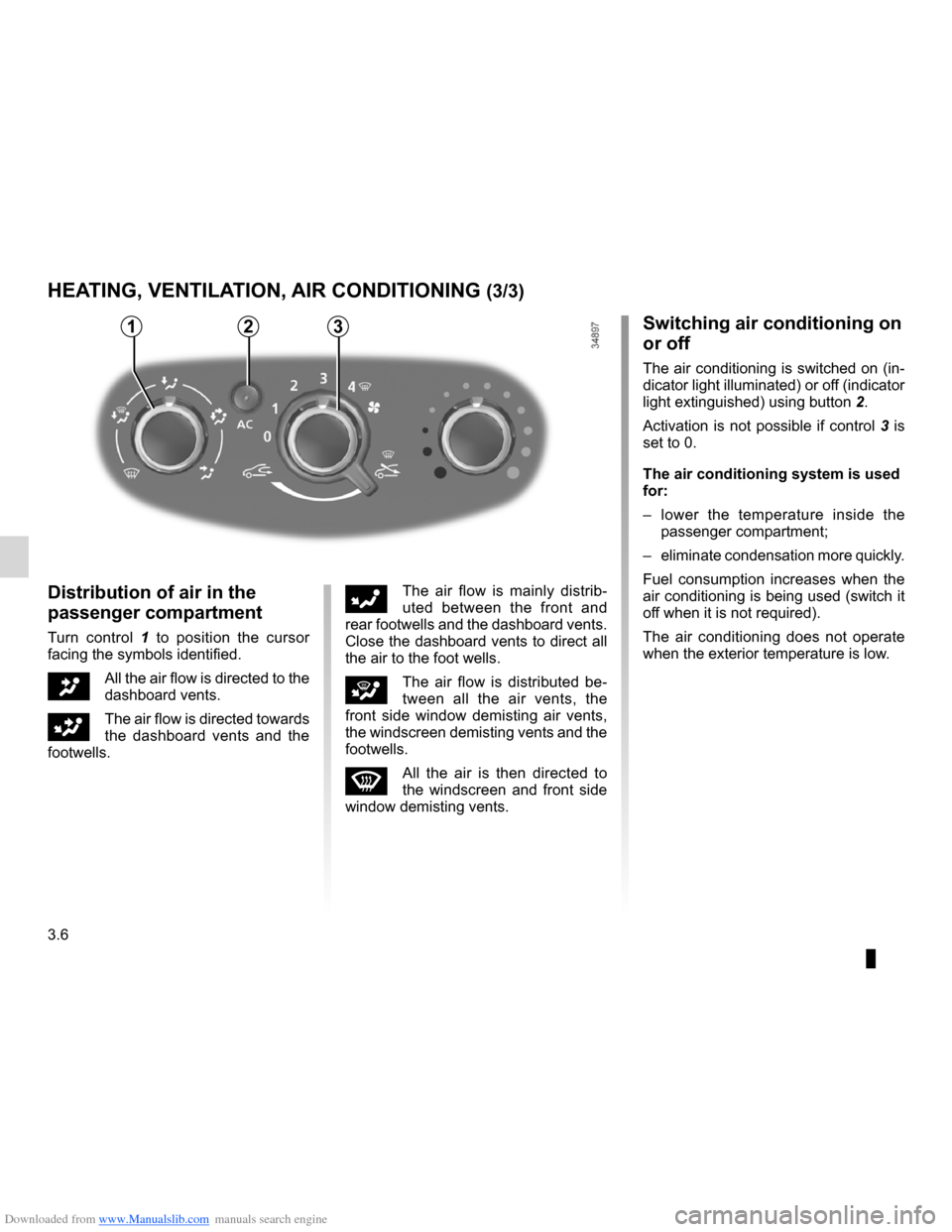
Downloaded from www.Manualslib.com manuals search engine demistingwindscreen ....................................................... (current page)
3.6
ENG_UD28036_3
Chauffage - Ventilation - Air conditionné (X92 - Renault)
ENG_NU_975-3_X92_Dacia_3
HEATING, VENTILATION, AIR CONDITIONING (3/3)
Distribution of air in the
passenger compartment
Turn control 1 to position the cursor
facing the symbols identified.
JAll the air flow is directed to the
dashboard vents.
GThe air flow is directed towards
the dashboard vents and the
footwells.
FThe air flow is mainly distrib -
uted between the front and
rear footwells and the dashboard vents.
Close the dashboard vents to direct all
the air to the foot wells.
iThe air flow is distributed be -
tween all the air vents, the
front side window demisting air vents,
the windscreen demisting vents and the
footwells.
WAll the air is then directed to
the windscreen and front side
window demisting vents.
Switching air conditioning on
or off
The air conditioning is switched on (in-
dicator light illuminated) or off (indicator
light extinguished) using button 2.
Activation is not possible if control 3 is
set to 0.
The air conditioning system is used
for:
– lower the temperature inside the
passenger compartment;
– eliminate condensation more quickly.
Fuel consumption increases when the
air conditioning is being used (switch it
off when it is not required).
The air conditioning does not operate
when the exterior temperature is low.
321
Page 92 of 196
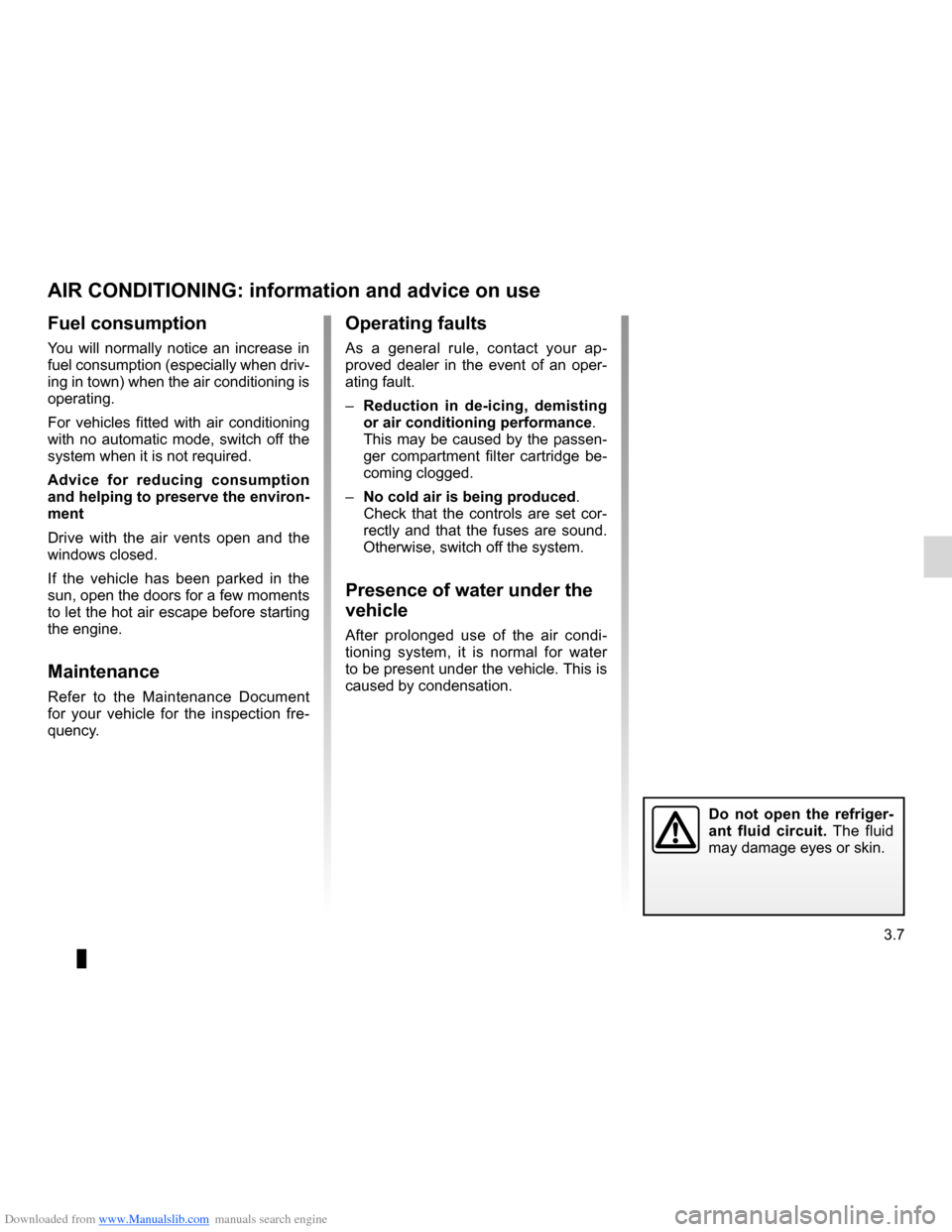
Downloaded from www.Manualslib.com manuals search engine air conditioning ..................................... (up to the end of the DU)
heating system ..................................... (up to the end of the DU)
heating and air conditioning system ..... (up to the end of the DU)
ventilation heating and air conditioning system (up to the end of the DU)
air conditioning ...................................................... (current page)
3.7
ENG_UD24441_1
Air conditionné : informations et conseils utilisation (X92 - Renaul\
t)
ENG_NU_975-3_X92_Dacia_3
Fuel consumption
You will normally notice an increase in
fuel consumption (especially when driv-
ing in town) when the air conditioning is
operating.
For vehicles fitted with air conditioning
with no automatic mode, switch off the
system when it is not required.
Advice for reducing consumption
and helping to preserve the environ-
ment
Drive with the air vents open and the
windows closed.
If the vehicle has been parked in the
sun, open the doors for a few moments
to let the hot air escape before starting
the engine.
Maintenance
Refer to the Maintenance Document
for your vehicle for the inspection fre -
quency.
Air conditioning: information and advice on use
AIR CONDITIONING: information and advice on use
Operating faults
As a general rule, contact your ap -
proved dealer in the event of an oper-
ating fault.
– Reduction in de-icing, demisting
or air conditioning performance .
This may be caused by the passen-
ger compartment filter cartridge be -
coming clogged.
– No cold air is being produced .
Check that the controls are set cor-
rectly and that the fuses are sound.
Otherwise, switch off the system.
Presence of water under the
vehicle
After prolonged use of the air condi -
tioning system, it is normal for water
to be present under the vehicle. This is
caused by condensation.
Do not open the refriger -
ant fluid circuit. The fluid
may damage eyes or skin.
Page 140 of 196

Downloaded from www.Manualslib.com manuals search engine tyre inflation kit...................................... (up to the end of the DU)
5.5
ENG_UD28665_3
Kit de gonflage des pneumatiques (X77 - X85 - B85 - C85 - S85 - X77 ph2\
- K85 - X95 - E95 - X67 - X92 - X10 - X98 - X52 - Renault)
ENG_NU_975-3_X92_Dacia_5
Tyre inflation kit
TYRE PREssURE KIT (1/3)
The kit is only approved for
inflating the tyres of the ve-
hicle originally equipped
with the kit.
It must never be used to inflate
the tyres of another vehicle, or any
other inflatable object (rubber ring,
rubber boat, etc.).
Avoid spillage on skin when han -
dling the repair liquid bottle. If drop-
lets do leak out, rinse them off with
plenty of water.
Keep the repair kit away from chil -
dren.
Do not dispose of the empty bottle
in the countryside. Return it to your
approved dealer or to a recycling or-
ganisation.
The bottle has a limited service
life which is indicated on its label.
Check the expiry date.
Contact an approved dealer to re -
place the inflation tube and repair
product bottle.
A
B
The kit repairs tyres when
tread A has been dam -
aged by objects smaller
than 4 mm. It cannot repair
all types of puncture, such as cuts
larger than 4 mm, or cuts in tyre
sidewall B.
Ensure also that the wheel rim is in
good condition.
Do not pull out the foreign body
causing the puncture if it is still in
the tyre.
Do not attempt to use the
inflation kit if the tyre has
been damaged as a result
of driving with a puncture.
You should therefore carefully check
the condition of the tyre sidewalls
before any operation.
Driving with underinflated, flat or
punctured tyres can be dangerous
and may make the tyre impossible
to repair.
This repair is temporary
A tyre which has been punctured
should always be inspected (and re-
paired, where possible) as soon as
possible by a specialist.
When taking a tyre which has been
repaired using this kit to be replaced,
you must inform the specialist.
When driving, vibration may be felt
due to the presence of the repair
product injected into the tyre.